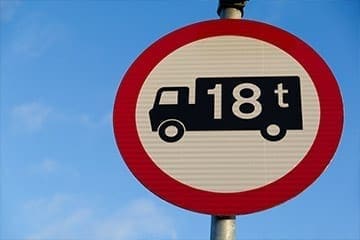- Car finance Car finance
- Motorbike finance Motorbike finance
- Van finance Van finance
- How it works How it works
- FAQs and guides FAQs and guides
- About us About us
- Home
- Blog
- Researching a Vehicle
- 8 ways that driving a van is different to a car
8 ways that driving a van is different to a car
Updated: Thursday, 14 March 2024
Driving a van for the first time can be challenging, especially if you’re used to being behind the wheel of a car. Before you start thinking about test driving or applying for van finance, make sure you can drive one.
In this guide, we explore the differences between driving a van and a car, including the rules around tax and MOTs and eight things you need to know before you get into a van’s driving seat.
Do you need a different driving licence to drive a van?
If you hold a full driving licence, you can drive a van weighing up to 3,500kg. The average van will weigh less than this, but you also need to consider what you will carry in the van and whether this will take you over the weight limit.
For context, the UK’s most popular van, the Ford Transit Custom (with no people on board) can weigh between 1914kg and 2246kg, depending on the model.
For further information, use the GOV.UK website to check what type of vehicles you can drive on your licence.
If you passed your driving test before 1 January 1997, you should have a C1 entitlement on your licence. This means you can drive a van and trailer combination up to 8,250kg maximum authorised mass (MAM).
If you passed your test after 1 January 1997, you can drive vehicles with a MAM of up to 3,500kg, carry a maximum of 8 passengers, and tow a trailer with a maximum weight of 750kg. The overall weight shouldn’t exceed 3,500kg.
You can read more about the driving licence categories on GOV.UK.
The maximum authorised mass, or MAM, is the overall weight of the vehicle, including:
- The driver
- Passengers
- All cargo
- Petrol and oil
To avoid potentially going over the MAM, check the weight of a van before you buy it to ensure you know how much cargo you can add to its load.
Can you drive a van on your driving licence?
If you hold a category B driving licence, you’re permitted to drive any van in the UK that weighs up to 3,500kg. The van can hold up to 8 passengers and tow a trailer weighing up to 750kg, but you must hold a C1 driving licence for anything bigger or heavy.
Head to the GOV.UK website if you need to add categories to your driving licence.
Van insurance, tax, and MOTs
You need to know about two types of van tax: vehicle excise duty (VED) and benefit-in-kind (BIK) tax. VED is the standard road tax that all vehicles, bar those with exemptions, are charged.
Van road tax is typically charged at a flat rate, but there are some nuances you need to be aware of. For example, if you run a Euro 4-compliant van registered between 1 March 2003 and 31 December 2006 or a Euro 5-compliant van registered in 2009 or 2010, you’ll pay a reduced VED fee.
In terms of BIK tax, you will be liable for this if you use your van for private journeys and work purposes.
A vehicle will be categorised as a van if it weighs less than 3,500kg, including car-derived vans. Your vehicle’s logbook (V5C) will tell you whether your vehicle is a van (classified as N1 or N2 on the V5C) or a dual-purpose vehicle (M1 or M2) and classified as a car.
In the UK, most vehicles need to be taxed, including vans. The only types of vehicles that are exempt from tax are:
- Vehicles used by a disabled person
- Vehicles used by organisations providing transport for disabled people
- Vehicles made before 1 January 1983
- Mobility vehicles and powered wheelchairs
- Electric vehicles
- Mowing machines
- Steam vehicles
- Vehicles used for agriculture, horticulture, and forestry, including tractors
You can check the current tax rate for a vehicle and whether it is currently taxed on GOV.UK. You can also find information about exemptions from vehicle tax.
Van MOTs
All vehicles must undergo an MOT every year once they reach three years old. For an MOT, a van will be classed in one of two categories:
- Class 4: up to 3,000kg in design gross weight. This includes car-derived vans.
- Class 7: if the van is over 3,000kg and up to 3,500kg in design gross weight.
MOTs ensure the vehicle is fit to drive and can help identify any problems before they worsen. Additionally, if you are caught driving your van without a valid MOT, you may be fined up to £1,000. You can find more information on GOV.UK.
Van insurance
As with any vehicle in the UK, you must have insurance to drive a van. The type of insurance you need will depend on whether you use the van for social or business purposes.
Read our guide to familiarise yourself with the different types of van insurance.
Eight differences between driving a van and a car
Now you know more about the differences between owning a van and a car, let’s explore the differences you’ll notice once you’re behind the wheel.
Speed limits
Before you set off, you need to know that van drivers must abide by different speed limits when using the roads. These speed limits also vary based on the type of van you’re driving.
Below are the standard speed limits for vans, car-derived vans, and vans towing a trailer. Remember that sometimes the speed limit might change, for example, if there are roadworks, so make sure you adhere to the road signage where applicable.
| Type of van | Built up area | Single carriageway | Dual carriageway | Motorway | Van | 30mph | 50mph | 60mph | 70mph |
|---|---|---|---|---|
| Car-derived van | 30mph | 60mph | 70mph | 70mph |
| Van and trailer | 30mph | 50mph | 60mph | 60mph |
If you need clarification on the types of roads, the 30mph speed limit applies to all roads with streetlights (unless stated otherwise). Remember, if you’re caught speeding, you could be fined up to £2,500, depending on the road you’re on, and receive up to 6 penalty points, which can increase your insurance premiums.
Driving a van for the first time can be challenging, especially if you’re used to being behind the wheel of a car. Before you start thinking about test driving or applying for van finance, make sure you can drive one.
In this guide, we explore the differences between driving a van and a car, including the rules around tax and MOTs and eight things you need to know before you get into a van’s driving seat.
Do you need a different driving licence to drive a van?
If you hold a full driving licence, you can drive a van weighing up to 3,500kg. The average van will weigh less than this, but you also need to consider what you will carry in the van and whether this will take you over the weight limit.
For context, the UK’s most popular van, the Ford Transit Custom (with no people on board) can weigh between 1914kg and 2246kg, depending on the model.
For further information, use the GOV.UK website to check what type of vehicles you can drive on your licence.
If you passed your driving test before 1 January 1997, you should have a C1 entitlement on your licence. This means you can drive a van and trailer combination up to 8,250kg maximum authorised mass (MAM).
If you passed your test after 1 January 1997, you can drive vehicles with a MAM of up to 3,500kg, carry a maximum of 8 passengers, and tow a trailer with a maximum weight of 750kg. The overall weight shouldn’t exceed 3,500kg.
You can read more about the driving licence categories on GOV.UK.
The maximum authorised mass, or MAM, is the overall weight of the vehicle, including:
- The driver
- Passengers
- All cargo
- Petrol and oil
To avoid potentially going over the MAM, check the weight of a van before you buy it to ensure you know how much cargo you can add to its load.
Can you drive a van on your driving licence?
If you hold a category B driving licence, you’re permitted to drive any van in the UK that weighs up to 3,500kg. The van can hold up to 8 passengers and tow a trailer weighing up to 750kg, but you must hold a C1 driving licence for anything bigger or heavy.
Head to the GOV.UK website if you need to add categories to your driving licence.
Van insurance, tax, and MOTs
You need to know about two types of van tax: vehicle excise duty (VED) and benefit-in-kind (BIK) tax. VED is the standard road tax that all vehicles, bar those with exemptions, are charged.
Van road tax is typically charged at a flat rate, but there are some nuances you need to be aware of. For example, if you run a Euro 4-compliant van registered between 1 March 2003 and 31 December 2006 or a Euro 5-compliant van registered in 2009 or 2010, you’ll pay a reduced VED fee.
In terms of BIK tax, you will be liable for this if you use your van for private journeys and work purposes.
A vehicle will be categorised as a van if it weighs less than 3,500kg, including car-derived vans. Your vehicle’s logbook (V5C) will tell you whether your vehicle is a van (classified as N1 or N2 on the V5C) or a dual-purpose vehicle (M1 or M2) and classified as a car.
In the UK, most vehicles need to be taxed, including vans. The only types of vehicles that are exempt from tax are:
- Vehicles used by a disabled person
- Vehicles used by organisations providing transport for disabled people
- Vehicles made before 1 January 1983
- Mobility vehicles and powered wheelchairs
- Electric vehicles
- Mowing machines
- Steam vehicles
- Vehicles used for agriculture, horticulture, and forestry, including tractors
You can check the current tax rate for a vehicle and whether it is currently taxed on GOV.UK. You can also find information about exemptions from vehicle tax.
Van MOTs
All vehicles must undergo an MOT every year once they reach three years old. For an MOT, a van will be classed in one of two categories:
- Class 4: up to 3,000kg in design gross weight. This includes car-derived vans.
- Class 7: if the van is over 3,000kg and up to 3,500kg in design gross weight.
MOTs ensure the vehicle is fit to drive and can help identify any problems before they worsen. Additionally, if you are caught driving your van without a valid MOT, you may be fined up to £1,000. You can find more information on GOV.UK.
Van insurance
As with any vehicle in the UK, you must have insurance to drive a van. The type of insurance you need will depend on whether you use the van for social or business purposes.
Read our guide to familiarise yourself with the different types of van insurance.
Eight differences between driving a van and a car
Now you know more about the differences between owning a van and a car, let’s explore the differences you’ll notice once you’re behind the wheel.
Speed limits
Before you set off, you need to know that van drivers must abide by different speed limits when using the roads. These speed limits also vary based on the type of van you’re driving.
Below are the standard speed limits for vans, car-derived vans, and vans towing a trailer. Remember that sometimes the speed limit might change, for example, if there are roadworks, so make sure you adhere to the road signage where applicable.
| Type of van | Built up area | Single carriageway | Dual carriageway | Motorway | Van | 30mph | 50mph | 60mph | 70mph |
|---|---|---|---|---|
| Car-derived van | 30mph | 60mph | 70mph | 70mph |
| Van and trailer | 30mph | 50mph | 60mph | 60mph |
If you need clarification on the types of roads, the 30mph speed limit applies to all roads with streetlights (unless stated otherwise). Remember, if you’re caught speeding, you could be fined up to £2,500, depending on the road you’re on, and receive up to 6 penalty points, which can increase your insurance premiums.
Weight limits
Every van has a maximum allowed weight, known as its design gross weight. Specific information about your van can be found on the Vehicle Identification Number (VIN) plate. These are usually found on the inside of the driver’s door.
It’s essential you know the maximum weight of the van before you start to load it, as you can be fined for driving an overloaded van.
Use the GOV.UK website to find your nearest weighbridge.

Weight limits
Every van has a maximum allowed weight, known as its design gross weight. Specific information about your van can be found on the Vehicle Identification Number (VIN) plate. These are usually found on the inside of the driver’s door.
It’s essential you know the maximum weight of the van before you start to load it, as you can be fined for driving an overloaded van.
Use the GOV.UK website to find your nearest weighbridge.

Extra gears
If you drive a car, you’ll likely be used to a gearbox with five forward gears; however, some vans have a sixth gear used for cruising at higher speeds on motorways. This sixth gear helps to keep revs down and reduce the demand on the engine, improving the van’s fuel economy and efficiency.
Manoeuvrability
Van driving is very different from driving a car, due to the higher seating position and larger vehicle size. This means navigating a car park can be tricky and squeezing into a parking space will be more challenging. You may need to adapt your driving style to accommodate the vehicle’s larger size and turning circle.
Visibility and blind spots
Most vans do not have a rear-view mirror, which can drastically impact visibility and mean you have to rely on your side mirrors. This increases the number of blind spots and the risk of getting into an accident.
Take the time to adjust your seating position and wing mirrors to get the best view of the road.
When driving an empty van, you will notice the suspension feels springier. This means you’ll need to take extra care when cornering, as taller vans could topple over at higher speeds.
Braking distance
There is a noticeable difference (33%) in the braking distance of an empty van compared to one carrying a large cargo load. This means that when carrying heavy items, you will need to drive more carefully to keep yourself and other road users safe. You’ll also notice a difference when cornering and should take extra care when approaching tight turns.
Fuel efficiency
Due to their larger size and weight, vans typically use more fuel than cars, especially if you carry heavy tools or goods. So, before you buy a new van, make sure you budget for the increased cost at fuel stations.
Dashboard layout
The control and dashboard of a van tend to be different to that of a car, so it’s essential you familiarise yourself with them before you start driving your van.
Tips on driving a van for the first time
Before you drive a van for the first time, make sure you get a proper feel for the controls and driving without a rear-view mirror to look through. Here are our tips for a successful first journey as a van driver:
- Know where you’re going and how to get there: knowing the route you’re going to take can help you prepare for tight bends or complex manoeuvres and help reduce stress while you’re in the driving seat.
- Take it slow: with increased stopping distances, especially if you’re carrying heavy cargo, you need to take extra care to avoid hazards while driving your van. Remember to leave plenty of space between you and the car in front and ensure you’re sticking to the different speed limits.
- Consider your cargo: every van has a maximum authorised mass, so you must ensure you are under this weight limit. When loading your van, be careful to avoid damaging the goods or injuring yourself. In some cases, moving heavy items could destabilise the van, so when you’re loading it up, put the heaviest items at the bottom and try to distribute the weight evenly.
- Be aware of blind spots: there’s a big difference in visibility between a van and a car, so get to know your blind spots and make sure your mirrors are correctly adjusted before you set off.
- Take someone with you: whether they’re helping you move the cargo you’ve transported or watching you into a space, taking a friend on your first van journey can make things much more straightforward.
For more van-driving guides, check out our guide to the difference between hybrid and electric vans.
Finance your next van with Moneybarn
If you’re looking to buy a van on finance, we can help. We have over 30 years of experience helping thousands of customers up and down the UK, even if they’re self-employed needing van finance.
To get started, try out our van financing calculator. Play around with it to get a rough idea of what your Conditional Sale agreement with us could look like.
When you’re ready, get a quote in less than 5 minutes. You’ll get an instant decision, and better yet, we only use a soft search at the point of application.
Representative 30.7% APR.
Extra gears
If you drive a car, you’ll likely be used to a gearbox with five forward gears; however, some vans have a sixth gear used for cruising at higher speeds on motorways. This sixth gear helps to keep revs down and reduce the demand on the engine, improving the van’s fuel economy and efficiency.
Manoeuvrability
Van driving is very different from driving a car, due to the higher seating position and larger vehicle size. This means navigating a car park can be tricky and squeezing into a parking space will be more challenging. You may need to adapt your driving style to accommodate the vehicle’s larger size and turning circle.
Visibility and blind spots
Most vans do not have a rear-view mirror, which can drastically impact visibility and mean you have to rely on your side mirrors. This increases the number of blind spots and the risk of getting into an accident.
Take the time to adjust your seating position and wing mirrors to get the best view of the road.
When driving an empty van, you will notice the suspension feels springier. This means you’ll need to take extra care when cornering, as taller vans could topple over at higher speeds.
Braking distance
There is a noticeable difference (33%) in the braking distance of an empty van compared to one carrying a large cargo load. This means that when carrying heavy items, you will need to drive more carefully to keep yourself and other road users safe. You’ll also notice a difference when cornering and should take extra care when approaching tight turns.
Fuel efficiency
Due to their larger size and weight, vans typically use more fuel than cars, especially if you carry heavy tools or goods. So, before you buy a new van, make sure you budget for the increased cost at fuel stations.
Dashboard layout
The control and dashboard of a van tend to be different to that of a car, so it’s essential you familiarise yourself with them before you start driving your van.
Tips on driving a van for the first time
Before you drive a van for the first time, make sure you get a proper feel for the controls and driving without a rear-view mirror to look through. Here are our tips for a successful first journey as a van driver:
- Know where you’re going and how to get there: knowing the route you’re going to take can help you prepare for tight bends or complex manoeuvres and help reduce stress while you’re in the driving seat.
- Take it slow: with increased stopping distances, especially if you’re carrying heavy cargo, you need to take extra care to avoid hazards while driving your van. Remember to leave plenty of space between you and the car in front and ensure you’re sticking to the different speed limits.
- Consider your cargo: every van has a maximum authorised mass, so you must ensure you are under this weight limit. When loading your van, be careful to avoid damaging the goods or injuring yourself. In some cases, moving heavy items could destabilise the van, so when you’re loading it up, put the heaviest items at the bottom and try to distribute the weight evenly.
- Be aware of blind spots: there’s a big difference in visibility between a van and a car, so get to know your blind spots and make sure your mirrors are correctly adjusted before you set off.
- Take someone with you: whether they’re helping you move the cargo you’ve transported or watching you into a space, taking a friend on your first van journey can make things much more straightforward.
For more van-driving guides, check out our guide to the difference between hybrid and electric vans.
Finance your next van with Moneybarn
If you’re looking to buy a van on finance, we can help. We have over 30 years of experience helping thousands of customers up and down the UK, even if they’re self-employed needing van finance.
To get started, try out our van financing calculator. Play around with it to get a rough idea of what your Conditional Sale agreement with us could look like.
When you’re ready, get a quote in less than 5 minutes. You’ll get an instant decision, and better yet, we only use a soft search at the point of application.
Representative 30.7% APR.
Bringing you tips on buying and maintaining your vehicle to make life on the road less stressful.
More from Moneybarn...
For a better road ahead
Moneybarn is a member of the Finance and Leasing Association, the official trade organisation of the motor finance industry. The FLA promotes best practice in the motor finance industry for lending and leasing to consumers and businesses.
Moneybarn is the trading style of Moneybarn No. 1 Limited, a company registered in England and Wales with company number 04496573, and Moneybarn Limited, a company registered in England and Wales with company number 02766324. The registered address for these companies is: Athena House, Bedford Road, Petersfield, Hampshire, GU32 3LJ.
Moneybarn’s VAT registration number is 180 5559 52.
Moneybarn Limited is authorised and regulated by the Financial Conduct Authority (Financial Services reference No. 702781)
Moneybarn No. 1 Limited is authorised and regulated by the Financial Conduct Authority (Financial Services reference No. 702780)




